Effective Methods for Eliminating Flies at Home
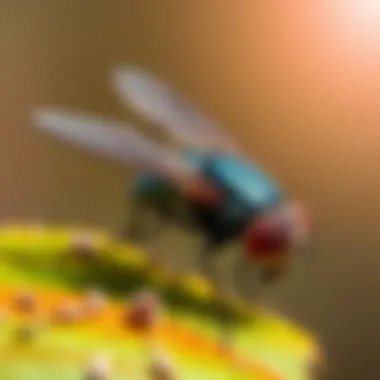
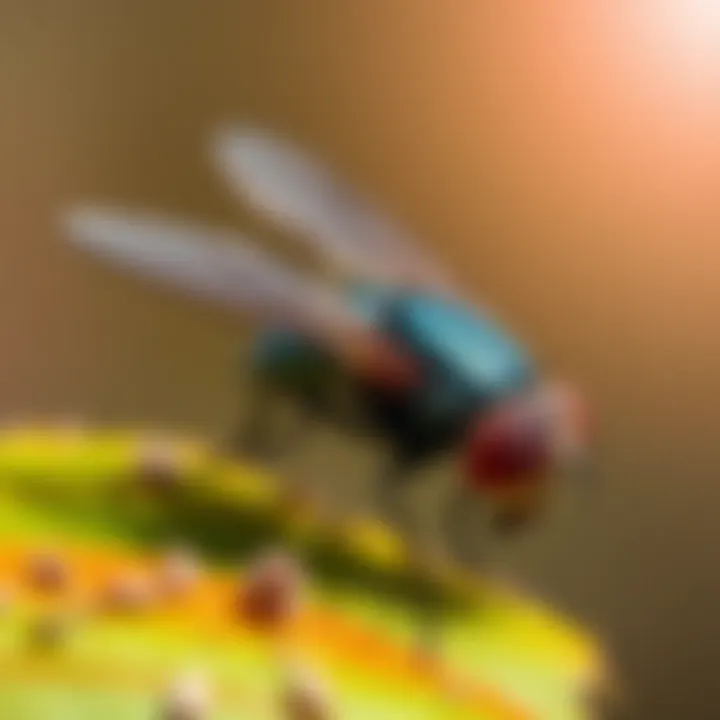
Intro
Flies can turn your serene abode into a buzzing battleground overnight. Their seemingly endless invasion may stem from various factors, often indicating deeper issues within your home. Understanding the context surrounding these pests is the first step in reclaiming your space. By surveying the specific types of flies that make themselves at home in your kitchen or living areas, and by implementing effective strategies for both removal and prevention, you can achieve a peaceful environment once more. This guide is tailored for housewives and homeowners seeking practical, effective methods for dealing with these relentless intruders in their homes.
Pest Identification
Before you can effectively eliminate flies, it's vital to understand who you're dealing with. Here are some common types and how to spot them:
Common Fly Types
- House Fly: These are the classic, grayish flies often seen hovering around food or waste. They tend to be around 1/8 to 1/4 inch long with a characteristic buzz.
- Fruit Fly: Smaller and more are persistent than house flies, these tiny bugs are often drawn to overripe fruits. Look for them around counters or trash cans.
- Drain Fly: Typically found in moist areas, these flies have furry bodies and resemble moths. They breed in drains and sewers, making identification crucial to effective control.
Signs and Symptoms of Infestations
- Visual Clues: Spotting a few flies here and there isn’t alarming, but a sudden surge may suggest an infestation. Check common gathering areas like kitchens and bathrooms.
- Breeding Grounds: Look for breeding sites like damp corners, leftover food, or any clutter holding moisture.
- Foul Odors: Sometimes, an unpleasant odor can reveal rotten food sources or waste, signaling a nearby fly breeding ground.
Prevention Strategies
Keeping flies at bay is as important as getting rid of them. Here are some strategies to ensure they don’t turn your home into their playground:
Home Maintenance Tips
- Seal Entry Points: Ensure windows and doors fit snugly. Utilize screens to block access while letting fresh air circulate.
- Regular Cleaning: A clean home is a less attractive home for flies. Regularly wipe down surfaces and ensure your kitchen remains free of crumbs and spills.
- Manage Garbage: Keep lids on trash bins tight and regularly dispose of garbage to reduce attractions.
Natural Deterrents and Barriers
- Herbs and Essential Oils: Flies dislike strong scents. Consider growing basil, mint, or using essential oils like eucalyptus and peppermint around entrances.
- Homemade Traps: A simple bowl of vinegar covered with plastic wrap has proven to attract and trap fruit flies effectively.
Treatment Options
When prevention measures fail, and flies invade, understanding the treatment options is critical:
Overview of Chemical vs. Natural Treatments
- Chemical Treatments: Products like aerosol insect sprays can provide immediate relief, though one must be cautious about toxicity levels, primarily if used indoors.
- Natural Solutions: For the more environmentally conscious or those with pets, homemade sprays using vinegar, dish soap, or essential oils may serve as effective alternatives without exposing inhabitants to harmful chemicals.
Step-by-Step Guides for DIY Treatments
- Vinegar Traps: Mix apple cider vinegar with a drop of dish soap in a bowl. Flies attracted to the vinegar will be trapped by the soap.
- Essential Oil Spray: Mix 10-15 drops of essential oil with water in a spray bottle for an effective repellent against flies. Spray around entrances and areas prone to infestations.
Each of these solutions prioritizes a dual approach—removal combined with prevention, much needed to combat the persistent presence of flies effectively.
To further enrich your knowledge on managing flies in your home, you can read resources from CDC.gov and explore community experiences on Reddit about handling flies.
Understanding the Fly Problem
House flies buzz around like they own the place, but their presence usually signals bigger issues. Understanding the fly problem is less about swatting indiscriminately and more about recognizing what draws these pests into your home, so you can put a stop to it effectively. Flies aren’t just annoying; they can also be indicators of poor sanitation and hygiene practices, sparking concerns that can affect your health and well-being.
Types of Flies Commonly Found in Homes
House Flies
House flies are the classic troublemakers lurking in kitchens and dining spaces. These common pests are not picky eaters; their diet consists of decaying organic material, which makes them frequent visitors to waste areas. It’s crucial to spotlight house flies in this article, as they are potential transmitters of filth, spreading germs with every short flight they take. One key characteristic is their rapid reproduction—this can lead to an overwhelming infestation if left unchecked. Their attraction to human spaces brings with it the risk of food contamination. In short, understanding house flies helps illuminate why maintaining a clean space is not just a matter of comfort but a necessity for health.
Fruit Flies
Next on the unwanted guest list are fruit flies. If you've ever seen tiny specks hovering around your bananas, you've encountered these little nuisances. Fruit flies have a hypersensitivity to the aroma of fermenting fruits, which they find irresistible. The unique feature of fruit flies is their rapid lifecycle; they can go from egg to adult in less than a week, making it essential to act quickly to deter them. While not as harmful as house flies, their presence can indicate that you’re not closely monitoring your produce, which can lead to further pest issues.
Drain Flies
Drain flies, often overlooked, love the damp environment found in sinks and floor drains. They lay their eggs near decaying organic matter, making neglected drains a prime breeding site. The squishiness of drain flies can be off-putting, but they play a role in indicating plumbing issues. Their unique feature, a fuzzy appearance, sets them apart from other flies, whose visibility invites immediate action. Understanding the role of drain flies helps homeowners recognize the importance of regular drain cleaning and maintenance in preventing future infestations.
Filth Flies
Filth flies thrive in areas rich in decayed organic matter, especially in trash bins and compost piles. Their very name suggests their association with unsanitary conditions. They are typically larger than house flies and have a slower flight pattern. This makes it easier to spot them around refuse. Being able to identify filth flies is crucial, as their presence can often signal a serious cleanliness issue in your home. By being aware of these flies, you can take your first step in addressing potential health risks.
Lifecycle of a Fly
Egg Stage
The lifecycle of a fly begins with the egg stage. Female flies lay hundreds of eggs in suitable environments, typically where there's plenty of food for the hatching larvae. This stage is crucial because it sets the gears in motion for the whole cycle. The fact that flies reproduce rapidly indicates why homeowners need to act swiftly upon noticing a problem. Understanding this stage can help emphasize vigilance in maintaining cleanliness in your home.
Lava Stage
After a few days, the eggs hatch into larvae, commonly referred to as maggots. This larval stage is particularly voracious and can cause further food contamination as they feed. Their development is crucial as well—quick intervention is key here as they can rapidly move towards adulthood in a matter of days, intensifying infestations if sanitation measures are not taken. With this knowledge, you can take control before they infest your home.
Pupa Stage
The pupa stage is a transformative phase where the larvae become adult flies. During this stage, they may not seem active, but they are preparing for emergence. Recognizing this phase helps illustrate why simply killing adult flies is not enough—the cycle needs to be broken at multiple stages for effective fly control.
Adult Stage
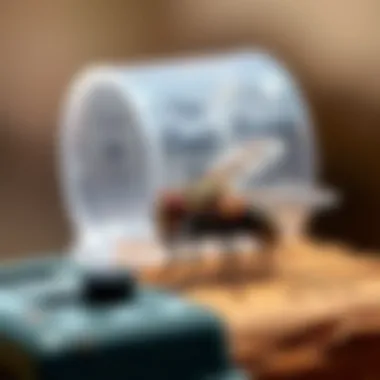
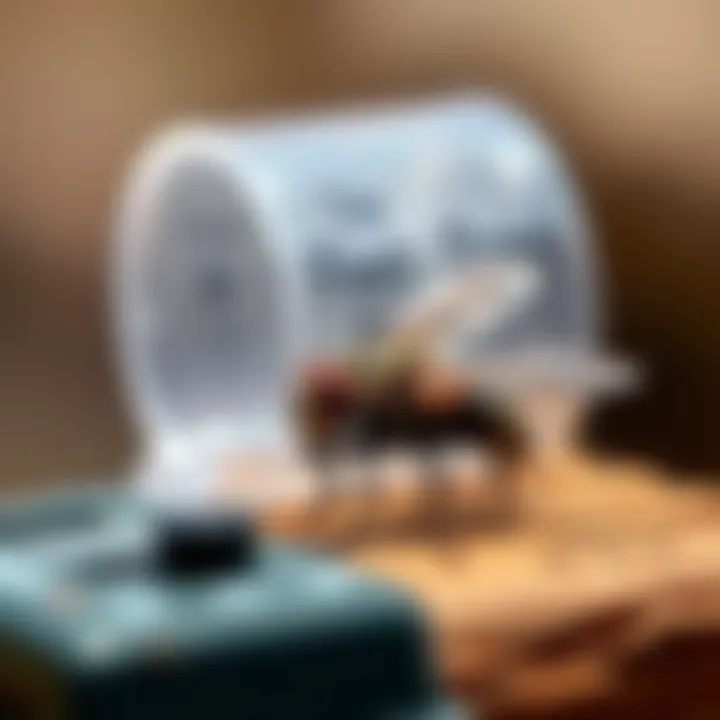
Finally, we arrive at the adult stage, where these pests continue their cycle, potentially infesting your home anew. Adult flies can live for a few weeks, and during that time, they can lay another batch of eggs, perpetuating the problem. Understanding this stage is vital; it serves as a reminder to remain vigilant and not allow the populace to flourish again.
Health Risks Associated with Flies
Disease Transmission
Flies are known carriers of various pathogens. They can pick up bacteria and viruses from their breeding sites, transferring them to food and surfaces they touch. The key takeaway is that an infestation can lead to health risks, especially for families with young children or elderly members. Knowing this underlines the importance of controlling fly populations and staying vigilant in hygiene practices.
Food Contamination
Flies often land on food, spreading their germs with every landing. Any area not kept clean can serve as a breeding ground for contamination. This isn’t just an issue for open food items; they can also contaminate cooking surfaces and utensils. The characteristic nature of food contamination so directly linked to the presence of flies—increasing the risk of foodborne illnesses—means that proactive measures are necessary.
Allergic Reactions
Lastly, let’s not forget the potential for allergic reactions. Some individuals may experience allergies as a result of contact with fly droppings or body parts. Although not every fly poses the same risk, being aware of this can help mitigate discomfort and health complaints. It stresses the importance of keeping spaces clean and fly-free for overall health.
By understanding the full scope of the fly problem, we’re better equipped to tackle these pests effectively and get back to comfortable living.
Identifying Attractants and Breeding Sites
Identifying attractants and breeding sites is essential in effectively managing the fly problem within your home. Flies are drawn to specific environments that provide food and reproduction opportunities. By understanding what attracts them and where they reproduce, homeowners can tackle the issue at its root, rather than applying quick fixes. This proactive approach not only reduces existing fly populations but also keeps future infestations at bay. Knowing these factors enables the implementation of tailored strategies that can make your living space less appealing to these pests.
Common Attractants in the Home
Food Sources
Food sources play a significant role in luring flies into living spaces. Uncovered food items, especially those with strong odors, are often the main culprits. For instance, ripe fruits or leftovers from dinner can tempt inquisitive flies. These food sources not only serve as a meal but also provide moisture, which is key for their survival. A notable characteristic of food sources is that they are not always obvious. Flies can be attracted to spilled liquids, crumbs, or even pet food. Therefore, being vigilant about food debris can deter these pests effectively. The drawback? Even keeping food tightly sealed might not be enough if crumbs remain on countertops or floors.
Trash and Waste
Trash and waste create a veritable buffet for flies. The smell and organic material present in decomposing waste are an irresistible draw. Flies are particularly fond of food waste, which can be a breeding ground for both the flies and their eggs. One key feature of trash sites is their accessibility; a simple unsecured lid or overflowing bag can invite a flock of flies. The primary downside is that once flies find a reliable food source, they can multiply quickly, increasing the difficulty of controlling them in other parts of the home. It’s best to regularly dispose of trash and ensure containers are sealed tightly.
Pet Waste
Pet waste is another major attractant that homeowners often overlook. Dogs and cats leaving their droppings in the yard can set the stage for a fly party. Flies are drawn to the scent of feces, and in a short time, your backyard can become their breeding haven. The notable characteristic of pet waste as an attractant is its ability to linger long after it's expelled, providing a continuous source of attraction. Although pet owners can control waste more effectively, pet habits and environmental factors can still pose challenges. Therefore, clean-up should be as routine as feeding your pets to keep flies away.
Standing Water
Standing water is like a welcome mat for flies, particularly species like mosquitoes. It offers hydration and serves as a breeding site. Even a small puddle, birdbath, or plant saucer can become a prime breeding ground. The key feature of standing water is how quickly it can accumulate in various parts of the home, making it hard to monitor effectively. Moreover, when it comes to outdoor areas, it's often a hidden threat, hiding in plain sight. Dealing with this issue is critical, as a small amount of stagnant water can lead to a significant fly problem.
Identifying Breeding Sites
Inside the Home
Inside the home, flies can find numerous cozy spots to breed if conditions are right. This includes damp areas like kitchens, basements, or laundry rooms where food residue might be present. A critical element of breeding sites inside the home is often unnoticed cleanliness. Even a tiny food particle hidden in a crack can lure flies and their eggs. By knowing this, homeowners should focus on regular deep cleaning, ensuring all surfaces are wiped down, particularly in areas where food is prepared. Failing to do this can lead to ongoing issues despite surface-level cleaning efforts.
Outdoor Areas
Outdoor areas are prime breeding grounds for flies, especially during warmer months. Gardens filled with organic material and refuse can turn into a breeding delight. A characteristic of these sites is their relatively easy access for flies coming from neighboring environments. Moreover, the natural organic refuse from plant life can also foster an inviting environment. Homeowners should pay attention to yard maintenance, as overgrown bushes or piles of leaves can amplify the problem. Understanding the relationship between landscaping and fly attraction can be the key factor in effective management.
Nearby Garbage Containers
Nearby garbage containers pose a serious threat not only in terms of access but also in terms of the potent smells they emit. Garbage cans, particularly if not cleaned regularly or if food scraps are collected without care, can become overflowing magnets for flies. A key characteristic of these containers is how often they might be overlooked during regular cleaning routines. They can also harbor breeding flies due to the residual waste materials that cling to the bins themselves. It is beneficial to actively maintain the cleanliness of outdoor garbage disposal points to prevent them from attracting fly populations.
Physical Removal Techniques
When it comes to tackling the problem of flies in the home, employing physical removal techniques is not just a good idea but often a crucial component of a comprehensive strategy. These methods provide immediate, though sometimes temporary, respite from these pesky insects while contributing to a cleaner and more pleasant living environment. They are particularly useful in conjunction with other more permanent solutions, as they can help minimize the fly population until longer-term control methods take effect. Practicality, ease of use, and effectiveness all play a role in the appeal of physical removal techniques, making them indispensable for homeowners.
Manual Capture Methods
Using a Fly Swatter
Using a fly swatter might seem old-fashioned, but it's a classic method that truly deserves recognition. It offers a hands-on approach that can be surprisingly satisfying. A fly swatter is lightweight and easily maneuverable, allowing precise aim when attempting to catch a sneaky fly in mid-air. The simplicity of this tool coupled with its effectiveness makes it a popular choice among many homeowners.
The unique feature of fly swatters lies in their design — typically a flat surface connected to a long handle. This design ensures you can safely distance yourself from the targeted fly while still hitting it in its tracks. However, it does require a bit of skill and timing, as flies are notorious for their swift movement patterns. While effective, there may be instances where the cleanup can get a bit messy, particularly if several flies are targeted in quick succession.
Catching With Sticky Traps
Sticky traps have become a go-to method for many when battling flies. Their effectiveness is both simple and efficient, leveraging an adhesive to capture flies without the fuss of manual swatting. These traps can be placed strategically in areas where flies are most active, acting silently while doing their job.
One of the standout characteristics of sticky traps is their passive nature; once they're put in place, they require no additional effort from you until it’s time to dispose of them. This can be particularly advantageous for individuals who may not have the time or patience to swat at flies constantly. On the downside, while sticky traps are effective at catching many flies, they don't necessarily deter new ones from entering. Thus, they work best when combined with other methods.
Vacuuming Flies
Using a vacuum to remove flies may sound unconventional, but it effectively combines speed and efficiency. Special attachments can facilitate this process, enabling you to zap flies with a simple squeeze of the trigger. It's a noiseless approach compared to swatting and keeps any bodily remnants contained within the vacuum.
The main advantage of vacuuming flies is the ability to clear a room of multiple flies quickly. It is especially useful in areas that may be hard to reach with traditional methods. Vacuuming can be effective, however, special care is needed to ensure the vacuum doesn’t end up clogged with organic debris. In addition, some people may find it alarming to use such a device on live insects, but for many, the tradeoff is worth the ease it brings.
Installation of Screens
Window Screens


Installing window screens may be one of the most preventative techniques against flies and other insects entering your home. With properly fitted window screens, you can enjoy daily fresh air without the worry of uninvited fly guests ruining the experience.
One key benefit of window screens is that they act as a barrier while allowing natural light and air to circulate freely within your space. This dual function is particularly appealing for homeowners looking to maintain comfort in their homes. However, it is essential to ensure they fit tightly in the frame; gaps can lead to flies finding their way in.
Door Screens
Door screens function similarly to window screens, providing an effective barrier against flies, particularly in areas that see a lot of foot traffic. They can come in various designs, such as magnetic screens that allow easy passage while sealing behind you to keep flies out.
Their primary appeal lies in their durability and convenience; they can be opened and closed with minimal effort. Despite this, door screens may sometimes come loose if not properly installed, and they will require regular maintenance to ensure they remain effective at blocking pests.
Screening Vents
Another underappreciated method for preventing flies is the installation of screens on vents. This technique ensures that any air circulation methods you use aren't inadvertently inviting flies indoors. While it may seem like a small thing, ensuring that your vents are screened can be crucial in maintaining a fly-free environment.
The standout feature of vent screens is their ability to filter air while preventing unwanted insects from entering. They can often be made to blend seamlessly with your decor, offering both aesthetic appeal and functionality. However, care should be taken to clean the screens regularly, as accumulated dust can eventually become a breeding ground for pests instead of a barrier.
Utilizing Chemical Solutions
Dealing with flies can sometimes feel like trying to trap smoke; they can slip through your fingers just when you think you’ve got them cornered. This is why chemical solutions often come into play as a crucial strategy in the fight against these pesky intruders. While natural methods hold their own charm, chemical interventions can provide a more immediate and powerful response, delivering results quickly to mitigate an infestation. A careful approach toward these products can ensure that you regain control over your living space decidedly.
Commercial Insecticides
Commercial insecticides offer a vast array of tools that can be effective against flies. The types of insecticides for flies can include sprays, baits, and even aerosol foggers. Each category serves a particular need, making it easier to tailor your approach to the specific circumstances of your fly problem. For instance, aerosol sprays can cover a wide area quickly and are particularly effective for immediate action. They are generally designed to kill adult flies on contact, addressing your issue with great swiftness.
One unique feature to consider with these products is the inclusion of residual action. Many insecticides remain potent for a certain period after application, which means they can continue to work even after you think you’re done spraying. However, it’s crucial to be cautious with this benefit, as it can also raise concerns about safety, particularly around pets and children. Overall, these chemical options stand out due to their efficiency and ability to provide rapid relief.
Types of Insecticides for Flies
Different types of insecticides have been developed specifically with flies in mind. One significant characteristic of these products is their capacity to disrupt the nervous system of these pests. Organophosphates, for example, are commonly used and are known for their effectiveness but come with serious health considerations. On the more natural side, pyrethrins, derived from chrysanthemum flowers, offer a less toxic alternative but still pack a punch against flies. Each option presents benefits and drawbacks—like efficacy against flies versus potential risk to non-target species and humans. Understanding these aspects is vital.
Application Methods
The application methods chosen can significantly impact the overall effectiveness of the insecticide. For example, ready-to-use sprays are often the easiest for homeowners to implement, as they require no mixing or special equipment. Simply point and spray directly at the flies or their breeding sites. This method is particularly beneficial for catching flies off-guard.
Another effective approach is using baits, which lure flies in with attractive scents. By targeting their hunger, this method can eliminate flies that would otherwise evade treatments. Fogging is commonly used for larger areas, creating a mist that permeates spaces, targeting flies hiding in crevices. However, it's important to remember that not every application method is suitable for every situation. For some, a more delicate approach might be necessary, particularly in areas with pets, and knowledge about the right method can save time and resources.
Safety Precautions
When utilizing chemical solutions, safety precautions cannot be overstated. It's essential to read labels carefully, following instruction explicitly. Many insecticides contain potent chemicals that could pose risks to children, pets, and even yourself if not handled properly. One critical aspect is ensuring proper ventilation when applying aerosol products, as inhalation can lead to respiratory problems.
Furthermore, using protective gear such as gloves and masks can add an extra layer of safety against skin and respiratory exposure. This is particularly true when dealing with concentrated formulations that require dilution. Disposing of leftover products and empty containers should also be done responsibly, adhering to local regulations, to avoid environmental contamination. Practicing these precautions isn’t just smart; it’s necessary for maintaining a safe home while tackling fly issues.
Homemade Fly Sprays
If commercial products don't appeal to you, homemade fly sprays can be a viable alternative. These sprays are often made with common household ingredients and can be quite effective, depending on your preferences and principles.
Essential Oils
One popular category within homemade sprays includes essential oils. These concentrated plant extracts are not just great for creating a peaceful ambiance; many possess natural insect-repelling properties. Oils like peppermint and eucalyptus have been noted not only for their pleasant scents but also for their effectiveness in repelling flies. This makes essential oils a beneficial choice for environmentally conscious homeowners.
However, a unique feature of essential oils is their volatile nature, meaning they dissipate quickly. This can be an advantage if one aims to avoid overwhelming scents but may require more frequent applications to maintain efficacy. Hence, while they are less hazardous compared to chemical insecticides, they may not always provide the long-lasting impact some folks need.
Vinegar Solutions
Another DIY option, vinegar solutions, offer simplicity paired with effectiveness. Vinegar’s acetic acid content can deter flies, making it a go-to ingredient for many home remedies. A common approach is mixing equal parts vinegar and water in a spray bottle or using it in traps to attract and drown the flies. This straightforward concoction is easy to prepare and can be a useful tool in your arsenal.
However, one of the drawbacks is that vinegar solutions are better as deterrents or traps rather than outright killers, which means success can vary widely depending on the severity of the fly emergence. Still, it's low-cost and eco-friendly, appealing to those looking for less harsh alternatives.
Soap Solutions
Soap solutions provide yet another method that is worth mentioning. Mixing liquid soap with water can create a solution that suffocates flies on contact. When applied directly, the soap can block the spiracles that flies use to breathe, leading to their quick demise. This method highlights effectiveness while still remaining in the realm of safe household ingredients.
A significant advantage of this approach is the common accessibility of soap in most homes. However, one thing to keep in mind is that not all soaps are created equally; be cautious with products that include added fragrances or dyes, as these may not be as effective or safe for your intended use.
In summary, understanding the pros and cons of commercial insecticides and homemade fly sprays can arm you with the knowledge needed to tackle your fly problem comprehensively. Ultimately, choices can cater to your preferences, needs, and ideals as a homeowner, ensuring a relatively fly-free living environment.
Preventative Measures to Keep Flies at Bay
Preventing flies from taking up residence in your home is just as vital, if not more so, than removing them once they've made themselves comfortable. Taking preventative measures is often the first line of defense against these unwelcome pests. By understanding how to make your home less appealing to flies, you can effectively minimize their presence. A clean environment, along with small adjustments in your daily routines, can work wonders in creating a fly-free zone.
Sanitation Practices
Regular Cleaning Routines
Engaging in consistent cleaning practices is one of the most effective ways to deter flies. Regular cleaning addresses not just visible dirt but also hidden crumbs and spills. Creating a routine where surfaces like counter tops and dining tables are wiped down daily helps remove any potential food sources that might attract flies. This is not just about tidiness; it's about maintaining an environment that is less hospitable to these insects.
The key characteristic of a regular cleaning routine is its reliability. A daily or weekly schedule not only keeps the home neat, but it also instils a sense of discipline that helps many other tasks flow more smoothly. While it may seem tedious, even a few minutes here and there can prevent the accumulation of grime that draws flies in like moths to a flame.
However, it’s essential to keep in mind that while it's effective, regular cleaning routines require commitment and consistency. Skipping even a week can result in noticeable fly activity, so it’s best to stick to it.
Proper Food Storage
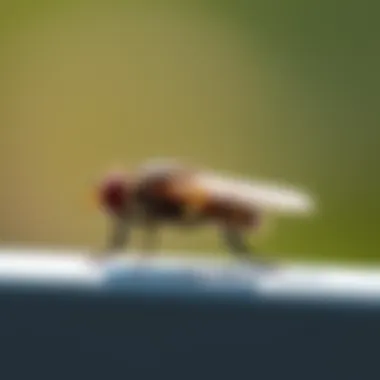
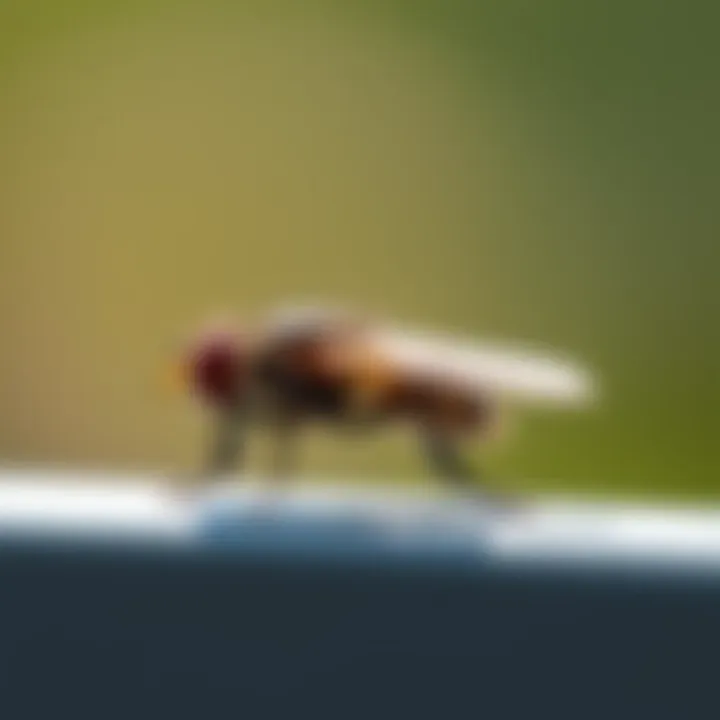
Next up is proper food storage, which is crucial in the battle against flies. This involves not only sealing food but also ensuring that it’s stored in containers that flies cannot penetrate. Whether it’s leftover takeout or baking supplies, keeping food sealed in airtight containers makes a world of difference. By keeping your food secure, you essentially cut off a primary food source that flies seek out.
The notable aspect of proper food storage is its simplicity. It doesn’t demand expensive tools or elaborate methods, just some reasonable practices. Yet, the advantage of this practice is significant—not only does it limit the opportunities for flies to feast, but it also instills better habits in the household, reducing overall wastage.
On the flip side, neglecting this aspect may seem harmless, but it invites flies in virtually unchecked. It’s one of those areas where the benefits far outweigh any slight inconveniences of having to be mindful about how food is put away.
Effective Waste Management
Effective management of waste is also a crucial component in preventing flies. This includes keeping trash bins covered, regularly removing rubbish from your home, and using garbage bags that are resistant to puncturing. Flies are drawn to decomposing organic matter, so the less accessible waste you have lying around, the better.
A key characteristic of effective waste management is the act of routine garbage disposal. Establishing a consistent schedule for taking out the trash reinforces cleanliness in the household. This not only contributes to reducing fly populations but also promotes a more pleasant living environment overall.
Nonetheless, managing waste effectively can sometimes face the challenge of forgetfulness. A household member may neglect to take the trash out on a scheduled day, which can quickly lead to unwanted visitors. Establishing reminders or creating visual cues can often be a solution to maintain this practice.
Environmental Modifications
Sealing Entry Points
Securing entry points is another fundamental preventive measure. Flies can easily enter through tiny gaps and openings, so sealing windows and doors can dramatically reduce their chances of entering your home. Using screens where appropriate also enhances this barrier against unwanted insects. This simple act of sealing entry points can substantially minimise the number of flies that make their way indoors.
This practice's key characteristic lies in its practicality. It often requires minimal time and effort – a quick inspection can reveal spots that need attention. The primary advantage is a more comprehensive defense against not just flies, but other pests as well.
Yet, ensuring that all potential entry points are secured requires consistent effort. Sometimes, homes may have hidden gaps that go unnoticed, which can lead to frustration when the fly population persists.
Landscaping Considerations
The role of landscaping in fly prevention is often overlooked. Specifically, ensuring that the yard is tidy can limit the breeding grounds for flies. Flies thrive in damp environments and cluttered spaces. Keeping grass trimmed, minimizing standing water, and removing any decaying organic material can greatly impact how inviting your property is to flies.
Landscaping's key characteristic lies in how it complements the indoor preventive measures. This outdoor practice directly contributes to the overall management of a fly-friendly environment. The unique advantage is that a well-maintained yard not only looks good but often discourages various pests from settling in.
On the downside, engaging in landscaping can take considerable effort, especially if significant work is needed. It can pose a challenge, especially for those not already inclined towards garden maintenance, but the potential to enhance outdoor living significantly offsets the difficulty.
Best Practices for Outdoor Areas
Finally, implementing best practices for outdoor areas can help keep flies at bay. This may include positioning compost bins away from the house, maintaining patio cleanliness, and ensuring that outdoor eating areas are free from food debris that could attract flies. Outdoor management plays as significant a role as indoor sanitation in preventing flies.
The unique aspect of these practices is that they make outdoor spaces not only more enjoyable but also safer and more welcoming. Moreover, they help to foster a sense of community, particularly if you’re vigilant about your outdoor areas when hosting gatherings.
Though some of these practices may involve substantial time and effort, their rewards often compound over time. Each step taken to improve outdoor environments not only reduces potential fly nesting spots but enhances your quality of life overall.
By understanding and implementing these preventative measures, homeowners can actively reduce the presence of flies, making their living spaces more enjoyable and healthier.
When to Call a Professional
When it comes to handling a fly problem in your abode, knowing when to take a step back and seek professional help is vital. There are scenarios where DIY methods simply won’t cut the mustard, and that’s when a pest control expert can make all the difference. Not only do they have the training, but they also have access to resources and tools that an average homeowner may not possess. A professional can assess your unique situation and offer tailored solutions that you might not even consider.
Moreover, the presence of flies often points to underlying issues, such as unsanitary conditions or even a structural problem that enables these pests to thrive. By contacting a professional pest control service, you gain insights not only into removing flies but also into preventing future infestations.
Signs of a Major Infestation
Excessive Fly Presence
An overwhelming number of flies is usually the first red flag that something may be amiss. When you notice flies buzzing around more than occasionally, it’s time to take it seriously. Excessive fly presence often indicates not just poor hygiene but also breeding grounds close by, whether it’s rotting food or stagnant water.
The key characteristic here is density. If you’re swatting one fly and you notice five others joining the party, you likely have an underlying issue at play. This is a beneficial choice for homeowners to recognize because acting quickly can prevent a full-blown infestation. The unique feature of an excessive fly presence is how it signals that swift action is required; the longer you wait, the worse the situation can become.
Infestation in Specific Areas
If you start finding flies congregating in particular spots, that's a tell-tale sign of an infestation. Imagine waking up to find one area of your kitchen suddenly swarming with these pests; it usually means that there’s an easy food source or a breeding site nearby.
The key characteristic of these hotspots is their concentration, whether that’s near your fruit basket or around your home's trash storage. Noticing flies in specific areas serves as a guidepost for where to focus your immediate attention. This can save time and hassle down the line, as targeting the right spots allows you to clean or treat more effectively. However, the challenge lies in pinpointing the source without just treating symptoms.
Associated Health Risks
Flies are more than just an annoying buzz around your ears; they can pose significant health risks, too. They can carry pathogens and transfer them onto surfaces and food, leading to serious health implications for you and your family. The presence of flies signals potential contamination that you can't afford to ignore.
Health risks associated with flies make it essential to see the bigger picture. The key characteristic here is their role as vectors for disease, leading to foodborne illnesses and allergic reactions. Understanding the health risks provides an impetus for action, making it a critical element in your decision to seek professional help. Ignoring this can lead to a cycle of illness and discomfort in your home, making hiring an expert a sensible move.
Choosing an Effective Pest Control Service
Researching Local Options
When it’s time to call in the cavalry, knowing how to research local pest control options will save you a lot of headaches. Look for services in your area that specialize in flies rather than a one-size-fits-all pest control. This nuanced approach means they have the expertise tailored to your specific plight.
A standout characteristic of researching local options is community feedback. Customer reviews, local forums, and even word of mouth from neighbors can offer rich information that will help you choose wisely. The unique feature in this process is the ability to compare services side-by-side, which means you can pinpoint the best fit for your needs. However, remember that not all companies offer the same quality, so take the time to do your homework.
Evaluating Service Effectiveness
Not all pest control services are created equal, so it’s crucial to evaluate their effectiveness based on various factors. Consider asking about their methods, tools, and consumer satisfaction rates. A good company should provide transparency about their approach and be willing to discuss previous successes in similar situations.
The key characteristic is consistency; a service that boasts of high success rates in controlling fly populations is what you want to look for. By understanding how they operate, you can make an informed decision. However, be wary of businesses that make grand promises without providing evidence; sometimes, the effectiveness can hinge more on what’s written in a glossy brochure than in practice.
Understanding Treatment Plans
Finally, grasping the details of a treatment plan helps demystify what you can expect from pest control services. Understanding what chemicals or methods will be used ensures that you and your family can maintain safety during the process. Ask for details about timeframes, follow-up visits, and guarantees of effectiveness.
The key characteristic lies in the transparency provided by the service. A thorough understanding prepares you, giving you the peace of mind that comes from knowing what you’re getting into. However, pay attention to the timing and procedures, as some treatments may require your family and pets to vacate the premises for a bit. On the whole, comprehending treatment plans can make dealing with a fly infestation a much smoother experience.



